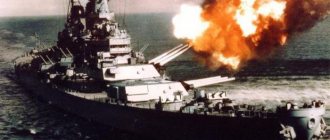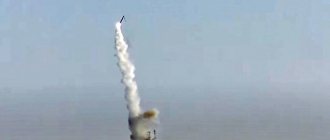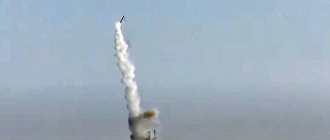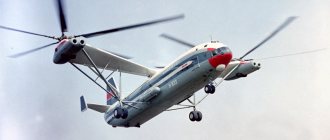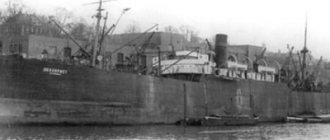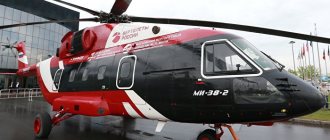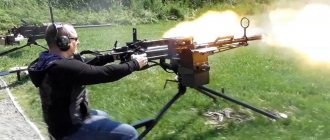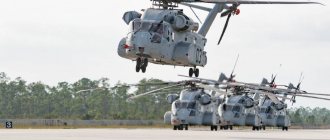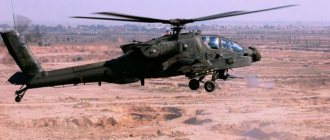A helicopter is a special aircraft that takes off and lands vertically. It rises into the sky thanks to one or more rotors with an engine. Initially, the helicopter was called a “helicopter”. This word was taken from French, which meant “spiral, screw.” The word helicopter appeared thanks to the Soviet aircraft designer Kamov. In many documents it began to be called already in 1929.
The main feature of the helicopter is that it can take off and land almost anywhere where there is a flat area. They can also easily perform various maneuvers. They can calmly hover in the air and fly backwards.
It is worth noting that helicopters are used to transport goods. But there are also disadvantages - not such a high flight speed compared to airplanes, as well as increased fuel consumption.
We present to you a list of the 10 largest helicopters in the world.
In this article we will look at the largest helicopters in the world.
Mi-24
Back in 1968, information was received about the creation of a high-quality helicopter called Mi-24 . It performed very well, so almost exactly a year later two more similar models were produced.
The first Mi-24 included a cabin with only 2 seats. But there are two built-in controls. In order to fly such a helicopter, you need not only a pilot, but also an operator who will monitor the condition and serviceability. Also, ideally, there could also be a flight mechanic.
There are pivot systems on the windows that allow you to fire personal weapons during the flight. The first models had quite a bit of armor, but in most cases it was still present.
It is for these reasons that the first people who flew helicopters wore body armor and helmets. Over the years, many such models have been created that have special capabilities.
Record holder
The largest cargo helicopter put into mass production is the Mi-26. Let's take a closer look at its characteristics and features. The machine was designed back in the seventies of the last century. The first flight took place in 1977. The main purpose of this device is the possibility of military use and use for civilian purposes.
Modern Mi-26s are designed primarily for the military industry; they can transport a huge number of passengers and heavy cargo. It is worth noting that the flight range is relatively short. Without refueling and cargo, with full fuel tanks, the helicopter can cover about eight hundred kilometers. The impressiveness of this machine is evidenced by its dimensions. The length of the aircraft is 40 meters, the diameter of the supporting propeller is 32 meters, and the width of the cargo compartment is 3.2 meters.
Bell AH-1 Super Cobra
The Bell AH-1 Super Cobra
model was developed in 1969 by the famous. It was created by order of the US Air Force.
Before this, the same models were not suitable for work. Pilots often complained that the helicopter made too much noise. This means that the ship can be easily attacked by the enemy.
We tested this model in Vietnam. But many helicopters were destroyed. It was only in 1970 that this project went into production. The armor has been greatly improved compared to the previous one. Equipped with aircraft cannons and missiles.
A pilot and gunner may be present on board. That is why the model is considered a combat model. It is not possible to transport cargo by helicopter. But it was created for completely different purposes.
The largest helicopter in Russia
The history of the creation of large Russian helicopters dates back to the Cold War in the USSR.
The atomic threat dictated the need to deliver large materials to those areas of the country that are difficult to reach by land transport. And the design bureau named after. Mil put all his efforts into creating a helicopter that could solve this problem. In 1967, the first flight of the Mi-12 helicopter, also known under the code B-12, took place. After two years of testing, the Mi-12 set a world record for lifting a load weighing 31, and then 40 tons to a height of 2250 meters. This figure has not yet been surpassed by any helicopter in the world.
Mi-12 is one of the largest Soviet helicopters
The Mi-12 successfully participated in international exhibitions, where it invariably became a real star. Of course, its dimensions are simply incredible - the diameter of its propellers is larger than the wingspan of a Boeing 747! This helicopter has a two-tier cabin that can accommodate six people and a huge cargo compartment. It could also carry up to 50 passengers.
Mi-12 is larger than many passenger aircraft
But only two such helicopters were built. The first prototype crashed during landing due to a hard landing. Flights of the second model ceased in 1974. It turned out that the production of this helicopter would be too expensive, and besides, large landing sites would need to be equipped for it. Both helicopters can now be seen in aviation museums.
Sikorsky CH-54 Tarhe
The Sikorsky CH-54 Tarhe
helicopter model was created in 1962 specifically for the United States Army. Used during the Vietnam War.
Initially, a helicopter was built with piston engines built into it. But we decided to make a model even more powerful and better.
The first such helicopter was made in 1962. Equipped with a fairly high chassis. Thanks to this, the model could be suspended on a variety of platforms. It also has the ability to transport even large loads. The characteristics greatly pleased the customers and the army.
It is worth noting that some models were purchased by private companies. In most cases, they are used for transportation and trawling of timber. But in the fire-fighting version there is an additional water tank.
Flying monsters: top 5 largest domestic helicopters
Heavy helicopters are being actively created all over the world, but it is Russia that invariably leads in this area, and neither the collapse of the Soviet Union nor the efforts of overseas “colleagues” who tried to squeeze domestic manufacturers out of the market could influence this. Aviation expert and military pilot Dmitry Drozdenko talks about the five heaviest helicopters in Russia.
One of the members of the American delegation told Soviet aircraft designer Mikhail Mil: “I just can’t believe that you Russians have surpassed us in the production of heavy helicopters!” This happened back in the sixties in France at the Le Bourget International Air Show. By that time, many leading aircraft manufacturing companies were engaged in the production of rotary-wing aircraft, whose bosses enthusiastically divided the sales markets. It was believed that the United States would produce at least two-thirds of all helicopters in the world. The British, French, Italians and even the Japanese were queuing up for the rest of the market share. Our country, as you understand, was not taken into account. As it turned out later, it was in vain.
Mi-4. Stalin's order
At the dawn of helicopter aviation, the USSR lagged behind its main geopolitical enemy, the United States. The big bosses did not really believe in rotary-wing aircraft and were skeptical about the possibility of their mass use among the troops. The successful American landing operation in Korea using Sikorsky S-55 helicopters radically changed the attitude towards them in the USSR. Changed it at the highest level.
Joseph Stalin demanded to “catch up and overtake” America. Soviet aircraft designers received the leader's order to make a transport helicopter in just one year. This process was personally supervised by Lavrentiy Beria. The impossible task was successfully solved by the design bureau under the leadership of Mikhail Leontievich Mil - in mid-1952, the Soviet Mi-4 helicopter took off into the air, the cargo cabin of which could accommodate 1600 kg of cargo or 12 fully equipped paratroopers. And that was just the beginning.
Mi-6. Nuclear cab driver
Why were such powerful machines needed? The answer is quite simple: it was a time of missile confrontation, and a heavy transport helicopter was needed to transport Luna mobile tactical missile systems. The solid-fuel missile could be equipped with a nuclear warhead, and the giant Soviet helicopter gave the complex unprecedented mobility for those times. The Mi-6, in a group with the An-12 aircraft, became a transport component of missile systems. And besides, such equipment gave our troops unprecedented mobility, since it could deliver not only manpower, but also light armored vehicles to almost any place on the map.
The first production giant helicopter was the Mi-6. It took off in 1957, just five years after the Mi-4 took off. It was the world's first production helicopter with two free-turbine gas turbine engines. Subsequently, this arrangement became internationally recognized and is now used on almost all modern medium and heavy helicopters.
The Mi-6 was also the first in terms of strength among helicopters of that time. The helicopter was lifting - just think about it! — 12 tons in a large cargo compartment and 8 tons on an external sling. The large wings with which it was equipped made it possible to significantly relieve the load on the main rotor in horizontal flight, as well as to take off with a large load, using “airplane-style takeoff.” The Mi-6 could reach speeds of up to 320 km/h and had a flight range of up to 1000 kilometers.
Mi-10. Air valve
A little later, the Mi-10 was developed on the basis of the Mi-6. The military purpose of this helicopter was to transport what the Mi-6 could not transport - large-sized elements of missiles, radar and much more. In 1961, this helicopter set a record - it lifted a load of 15 tons to a height of more than 2,000 meters. The Mi-10 had an unusual appearance: a narrow fuselage, a long, almost 4-meter, stilt-like chassis with a cargo platform fixed between them, and the right struts were 30 centimeters shorter than the left ones. This was done so that the helicopter would simultaneously tear off all the landing gear during takeoff. One of these helicopters was modified specifically to set a cargo lifting record. This machine lifted 25 tons into the air.
In 1966, its new model was built - the Mi-10K, on which they tried to take into account the shortcomings of the first modification. The model had short “legs” and was equipped with a special cockpit in which the pilot-operator could control the helicopter, sitting facing the tail and looking directly at the load on the external sling. This made it possible to carry out unique installation operations using a helicopter.
But the car still had many shortcomings. The military past, increased vibration and some design flaws did not allow the Mi-10 to easily transition to civilian life, and this despite the excellent opportunities and economic benefits that the flying crane provided to the national economy. The development of the helicopter continued for several years, and only in 1974 the Mi-10K went into production. The machine has completed many uniquely complex construction operations around the world and has been in use to this day.
AT 12. Strategic "Homer"
Another heavy, or more correctly, super-heavy, rotorcraft was the Mi-12, which received the name Homer according to NATO codification. The transversely spaced 35-meter propellers of the power plants belonged to the Mi-6 helicopter. In fact, there was one heavy helicopter at the ends of the giant's wings. A celestial giant with a take-off weight of 105 tons and a total power of four engines of 26,000 hp. flew surprisingly easily and quietly. There was no strong vibration inherent in large helicopters, which was a real scourge of that time. Incredible figures for that, and even for our time, the B-12 lifted more than 44 tons to a height of more than two thousand meters. No, and there is no helicopter with similar parameters expected in the world. The B-12 was supposed to work in tandem with the An-22 aircraft, ensuring the delivery of strategic missiles, so the B-12 can rightfully be called a “Strategic Helicopter”.
The helicopter's wings were special - they tapered as they approached the fuselage. In horizontal flight, the wings created additional lift and at the same time reduced the efficiency of the rotors, inhibiting the air flow from them. The narrowing of the wing made it possible to reduce this effect in the area of the maximum speed of air flow from the propellers and provided 5 additional tons of thrust. There was a transmission inside the wing that synchronized the propellers, preventing the blades from overlapping, and allowed the helicopter to continue flying if the engine group of one of the sides failed. This design was a great know-how, and it was patented abroad.
But only two cars were built, after which the program was closed. The reason is quite simple - rockets “lost weight” and began to be placed on railway and wheeled vehicles, and silo complexes appeared. The unique rotorcraft became unnecessary for the military, and the B-12 was too expensive for civilian life. Fortunately, both machines have been preserved and can be seen at the aviation museum in Monino and at the site of the Mil Moscow Helicopter Plant. The invaluable experience gained during the creation of hero helicopters was not wasted.
Mi-26. Raised Chinook
The culmination of the line of these outstanding machines was the Mi-26, which is still in production today and is the most powerful production helicopter in the world. It may not be a match for the mighty B-12, but its ability to calmly “yank” a weight of 20 tons makes it unsurpassed in the 21st century. In 1982, the crew of test pilot G.V. Alferov on the Mi-26 lifted a load weighing 25 tons to a height of 4060 meters. The helicopter holds 14 world records.
The Mi-26 is a multifunctional helicopter, without which civil and military aviation is unthinkable. It was this machine that extinguished the reactor in Chernobyl, it was the one that fought natural disasters. With the help of the Mi-26, unique construction and installation operations were carried out during the preparation of the Olympic Games in Sochi, which made it possible to preserve the nature of Krasnaya Polyana.
This case is indicative. In 2002, our civilian Mi-26 aircraft provided assistance to the US armed forces. Our helicopter transported a downed Boeing CH-47 Chinook helicopter, the heaviest rotorcraft of the US Army Aviation, from remote areas of Afghanistan to the American base in Bagram. No other car, including the famous Sikorsky CH-53, could handle this. All serial American heavy helicopters have never been able to approach the Mi-26 in their capabilities.
What do they have?
What is the situation with heavy helicopters abroad? The leader in this area is clearly the United States. The currently most powerful Western helicopter, the Sikorsky CH-53K King Stallion, also built according to the classical design, lifts only 16 tons into the air, and then only on an external sling. The cockpit can accommodate 37 paratroopers with full gear, versus 70 of our soldiers in the Mi-26. The famous "flying car" Chinook also takes about 40 soldiers, 6.3 tons in the cabin and 10.3 on the external sling. Therefore, I don’t want to compare them, and everything is clear.
Heavenly giants from Russia
Our country has amazing, invaluable experience in the field of helicopter manufacturing, and in the segment of medium and heavy transport we have no equal. This experience was acquired for a reason. There were many new and sometimes bold ideas. After all, a variety of layout solutions were worked out. There were successes, there were, like everyone else, failures. The latter did not pass without a trace, because it was thanks to them that our helicopter science took the right path. I would like to believe that in the future we will see new flying giants from Russia.
Text: Dmitry Drozdenko
Photo: Alexey Ivanov TRC Zvezda / Russian Ministry of Defense / Marina Lystseva / Drozdenko Video: Hamilton's Military Channel / youtube
Hughes XH-17
The model called Hughes XH-17 is designed for construction and installation work, as well as transportation of various cargoes. Also called “helicopter crane” or “flying crane”.
It is worth noting that in most cases cargo is transported suspended. In 1946, the Ministry of Defense decided to announce a competition. It is necessary to transfer a fairly large container. At the same time, the structure had to be easily disassembled.
The military decided to split the production into 2 phases. Subsequently, the Hughes XH-17 helicopter was created. In 1952, it took off for the first time, but was completed and corrected many times, as previous models had accidents.
Specifications
| Parameter | Characteristic |
| Main rotor diameter | 32 m |
| Number of rotor blades | 8 |
| Area swept by the main rotor | 804.25 m² |
| Tail rotor diameter | 7.61 m |
| Length | 40.025 m |
| Fuselage length | 33.727 m |
| Main rotor height | 8.145 m |
| Chassis base | 8,950 m |
| Chassis track | 5,000 m |
| Empty mass | 28,200 kg |
| Normal takeoff weight | 49,500 kg |
| Maximum take-off weight | 56,000 kg |
| Load capacity in cargo compartment | 20 t |
| Load capacity on external sling | 20 t |
| Cargo compartment length | 12.0 m |
| Cargo compartment width | 3.2 m |
| Cargo compartment height | 3.1 m |
| Cargo hatch dimensions | 2.9 x 3.2 m |
| Cargo compartment volume | 110 m3 |
| Mi-26 crew | 6 |
| Mi-26T2 crew | 2 people (3 people with external load sling) |
| Passenger capacity (soldiers) | 85 |
| Capacity of passengers (troopers) | 70 |
| Passenger capacity (stretchers for the wounded) | 60 + three health workers |
| Fuel tank capacity | 12,000 l |
| Volume of external fuel tanks (PTB) | 14,800 l in four tanks or 4,780 l in two tanks |
| Power point | 2 × turboshaft "Motor Sich" D-136 |
| Engine power | 2 × 11,400 l. With. |
| Jet fuel consumption | 3100 kg/hour |
| Maximum speed | 295 km/h |
| Cruising speed | 265 km/h |
| Flight range at maximum fueling | 800 km |
| Flight range at maximum load | 475 km |
| Flight range during ferrying | 2350 km (with four PTB) |
| Service ceiling | 4600 m |
| Static ceiling | 1800 m |
| Dynamic ceiling | 6500 m |
Boeing MH-47E Chinook
The Boeing MH-47E Chinook is considered one of the best American military transport helicopters. Actively used since 1960. It is in operation in almost twenty countries around the world.
It has proven itself well in Vietnam. It was used not only for transportation, but also as a producer of curtains of smoke, as well as spraying aerosols.
About 14 of these models were lost in the Iraq War. Then the military faced a serious problem. In 2005, a Chinook helicopter was shot down, killing about 16 soldiers.
Mi-26T2: not just modernization
In 2010, the program to modernize the Mi-26T helicopter into the Mi-26T2 variant was completed. The upgraded Mi-26T2 helicopter made its first flight on February 17, 2011.
The Mi-26T2 is not just another modernization of the world-famous “heavyweight”, it is already a radical change in image, experts assure. The main distinguishing feature of the new vehicle will be the use of digital avionics and a crew reduced to two people.
The decision to reduce the jobs of the navigator and flight engineer required the creation of a completely new cockpit layout and the installation of an on-board avionics complex that would allow two pilots to operate safely and efficiently.
The new avionics-26 complex has significantly increased the reliability and safety of the Mi-26T2 flight and will improve the stability and controllability of the vehicle, as well as hovering accuracy, which is especially important when using an external sling. In addition, to monitor the condition of the cargo on the external sling, an on-board television installation is used, transmitting images to the dashboard indicator.
Thanks to the new set of on-board equipment, Mi-26T2 flights can now be carried out at any time of the day and in difficult weather conditions.
As experts note, the modernized Mi-26T2 is in demand not only in Russia, but also on the international market, where interest in heavy helicopters still remains at a high level. In particular, already in 2013 the first export contract was concluded with Algeria, and a little later Jordan became the second foreign customer.
Sikorsky CH-53E
The model, which is called Sikorsky CH-53E , is one of the heavy transport helicopters. First flew in 1964. A total of 522 such vessels were built.
Quite a few structures were involved in production as well as development. It was decided to build something new, better than previous models. The United States lost approximately 36 helicopters during the Vietnam War.
One of the cases occurred in Israel. The engine caught fire, but the pilots managed to escape. They managed to land the helicopter on the ground, but then it exploded.
Mi-10
The Mi-10 was often called a “flying crane”. Was created in 1961. Began production at the helicopter plant in Rostov.
Initially, the construction of the helicopter was carried out to lift a load weighing 15 tons. Many other factors were added during the design. For example, the fuselage was made narrower and lower.
The first models burned out due to technical faults. But those who followed were able to cope with even the most difficult tasks.
B-12 - the largest helicopter in the world
The B-12 is the world's highest-capacity and heaviest helicopter ever built. According to NATO classification: "Homer" or "Homer". Equipped with wings on which propellers are placed. This type of design was originally proposed by the developer.
Soviet B-12 is a Soviet machine, the brainchild of the Moscow Helicopter Plant named after M.L. Mile. The main task of the designers is to create a super-heavy transport helicopter for transporting parts of intercontinental ballistic missiles. Development began in 1963.
Mi-6
The Mi-6 is a Soviet helicopter that was built in the 1950s. It was then that the USSR began to require a vessel for lifting large loads.
Its first flight took place in 1957. Previously, all necessary tests were passed on the model. Built at a plant in Rostov. It was originally designed for both military and civilian purposes.
This helicopter was the first model to be equipped with two turboshaft engines. It was manufactured at the same time in Moscow. Production continued until the 1980s.
It is worth noting that in 1961, this particular model became the first machine in the world to exceed a speed of 300 km per hour, which is considered quite high for helicopters. Currently, sixteen records of the Mi-6 are known.
Largest unmanned helicopter
Equally important is the development of unmanned helicopters that can lift quite significant weight. Last year, the world's largest drone was tested at a California naval air base. The MQ-8C Fire Scout helicopter is based on the unmanned Schweitzer 333 and can lift a load of up to 450 kg.
MQ-8C "Fire Scout" the largest unmanned helicopter
This model can stay in the air longer than all its predecessors. Its also advantage is that in adverse weather conditions it provides greater flight stability. At a speed of 200 km/h, the MQ-8C can stay in the air for up to 24 hours.
The only drawback of unmanned helicopters is that in an unfavorable situation it can fall into the hands of the enemy. Therefore, the creators of the MQ-8C are seriously working on this problem. After improvements and necessary modifications, mass deliveries of the helicopter are planned for 2016.
The large MQ-8C Fire Scout drone can stay in the air all day long
Mi-26
The Mi-26 is known to many as a Soviet and Russian helicopter. Produced in large volumes at a plant called Rostvertol.
The developer of this project was the Mil Design Bureau. The first time a helicopter took off was in 1977. Pilot Karapetyan agreed to the tests. It was produced more widely only after 1984.
In 2011, 316 such models became known. There are also landing options that are designed for 82 people. The sanitary room can accommodate about 60.
A helicopter can transport cargo up to twenty tons. Used by both the military and ordinary civilians.
Design
After successful experience using the Soviet Yak-24, the USSR Council of Ministers adopted a document on the creation of a new heavy helicopter with four engines. Initially, the Yak-60 project was considered, but it was abandoned for many reasons.
Cargo transportation B-12 for air
Mil OKB took up the proposal in 1958, the project was soon approved, and construction began. The prototype was the Mi-6, already built by that time, but the number of propellers was doubled. Each wing had two 6,500 hp engines. every. The rotorcraft design allows you to pass the transmission shaft inside, synchronizing the speed of the propellers.
By
